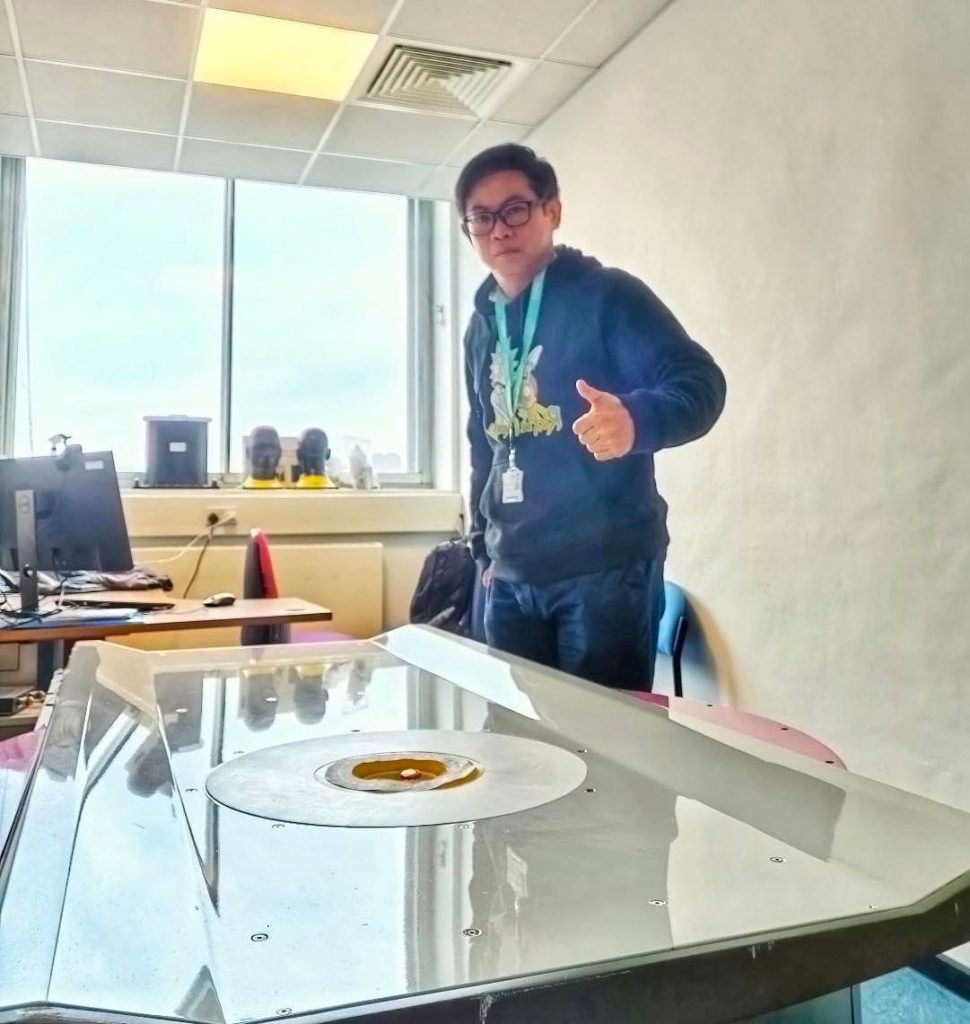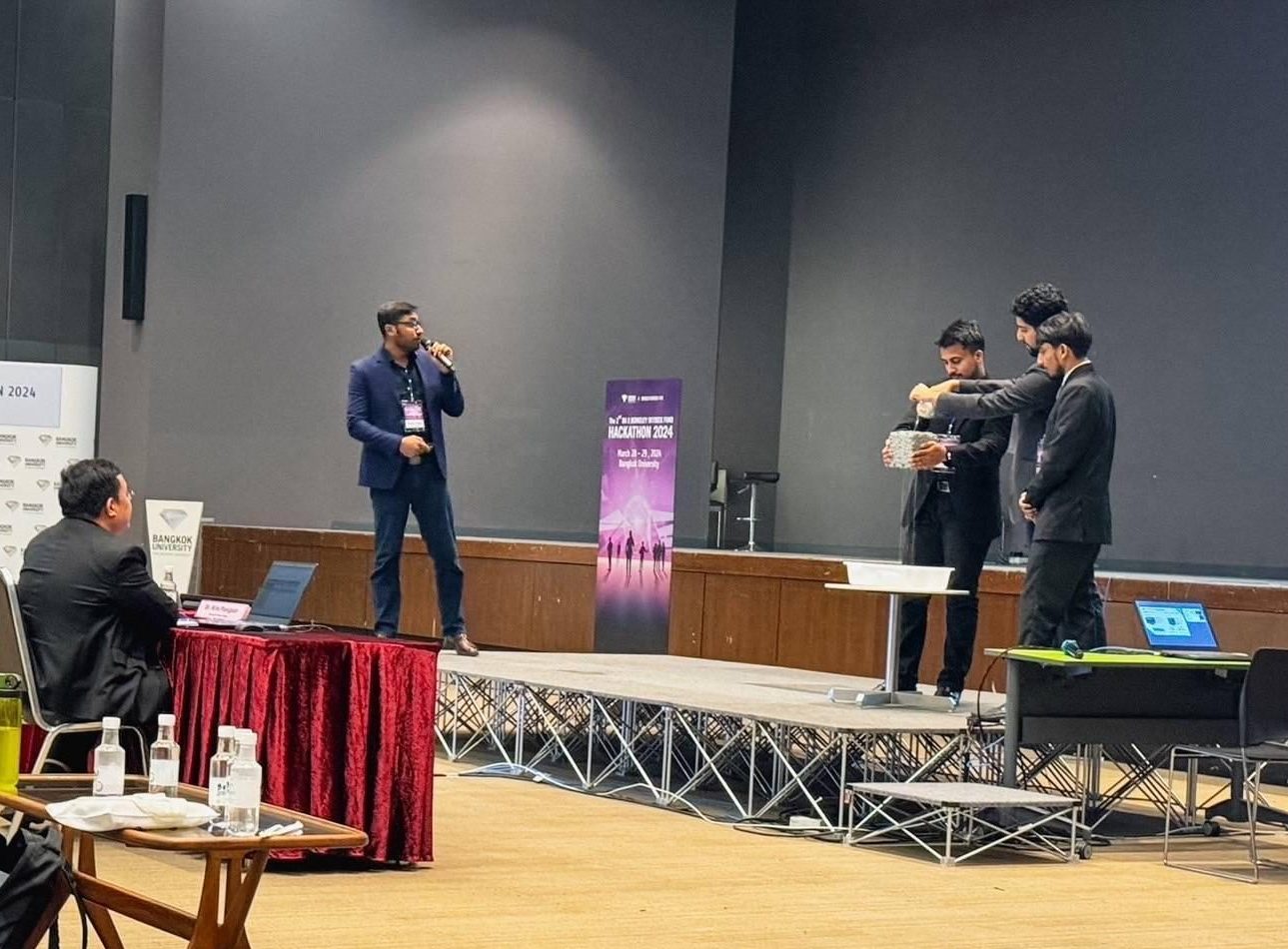By Shawn Kelly
AIT telecommunications scientist advancing work on wireless body-centric diagnosis methods and Artificial Intelligence to improve patient care.
Cancer is the planet’s ultimate killer. It touches humanity in every corner of the globe and its numbers are staggering. With 10 million deaths in 2020, cancer was the second leading cause of death in the world. Every sixth death on earth is due to cancer.
According to the World Cancer Research Fund (WCRF), 18.1 million new cancer cases were identified globally in 2020, of which 9.3 million were among men and 8.8 million were among women. Breast cancer was the most common cancer worldwide with 2.26 million cases detected, followed by 2.06 million diagnosed for lung cancer, equalling 12.5% and 12.2% of the total number of new cases diagnosed respectively in 2020.

Recently back in Thailand from a one-month study and teaching assignment at London South Bank University in the United Kingdom, Assoc. Prof. Dr. Attaphongse Taparugssanagorn, a Telecommunications expert at AIT’s Department of Information and Communications Technology who goes by nickname “Dr. Pong”, is optimistic that advances in the application of advanced wireless communications, microwave imaging, artificial intelligence (A.I.) and Internet of Things (IoT) can offer non-invasive, radiation-free, and low-cost alternatives to traditional cancer and stroke detection techniques.
“These are some of the most pressing and challenging medical issues of our time, affecting millions of people worldwide,” Dr. Pong said. “A.I. and machine learning and their smart application to medical imaging data offer new opportunities to improve the accuracy, speed and effectiveness of screening and cancer diagnosis, which could lead to better outcomes for patients.”
Cancer itself is a generic term for a large group of diseases that can affect any part of the human body with potentially lethal, abnormal cell growth. With no outright cure, it has been a part of the human experience for millennia, with descriptions of the disease’s incurability found on 5000-year-old papyrus texts of the Egyptians.
Today, about one-third of common cancers are preventable and treatable. Medical scientists know that surviving cancer improves when the disease is detected in its early stages, enabling treatments to slow or prevent its spread and lethality. Still, the data indicates that 50% of the over 100 cancers are diagnosed at an advanced stage, which lowers the odds.
In the case of breast cancer, diagnosis is typically made through standard X-ray or ultrasound imaging at the hospital. X-ray mammography is a commonly used tool, but can be less effective in women with dense breast tissue, and it has a risk of harmful radiation exposure and false positive results. Ultrasound too but has limitations, such as the inability to detect small or deeply-situated tumors in a patient.
Scientists with the project say recent advances in computer-aided diagnosis systems have helped to improve accuracy, but still face some limitations. Magnetic resonance imaging, known as ‘MRI’ is one option, but it is expensive and time-consuming.
Dr. Pong’s work on advanced wireless communication systems, signal processing and machine / deep learning for on-body and remote sensor networks is based on his participation the European Union-funded ROVER project that is brings together a multidisciplinary collection of international experts from multiple countries to develop non-invasive on-body and in-body wireless technological innovations to improve patient care.
He explains the science: “Wireless Ultra-WideBand (UWB) technology is a type of wireless communication signal that is used for short-range, high-bandwidth applications such as radar, imaging, and communication. Signal processing techniques are used to extract relevant features from these signals, and machine and deep learning techniques are used to recognize patterns in these features that can be used for a variety of applications, including healthcare. Machine / deep learning, which is a subfield of A.I., involves teaching computers to learn from data and to make predictions or decisions based on that learning. In this case, mathematical algorithms are being used to analyze medical imaging data to assist in the detection of breast cancer, lung cancer, and stroke.”
Overall, A.I. has the potential to improve accuracy and efficiency in medicine, scientists say. By analyzing large amounts of data, machine learning algorithms can identify patterns and features that may be difficult for human experts to detect, and help to detect diseases at earlier stages when they are more treatable.
Case in point, stroke, which is a serious life-threatening medical condition that happens when the blood supply to part of the brain is cut off. It is often referred to as a silent killer. Early detection and treatment are critical to prevent irreversible brain damage. Here the approach is to use medical imaging, such as Computed Tomography (CT) or MRIs, to identify regions of the brain that could be affected.

“Machine learning algorithms can then be used to analyze the images and identify subtle changes that may be indicative of a stroke, even in cases where there are no obvious symptoms,” Dr. Pong said. “For example, algorithms can be trained to recognize patterns in the brain’s blood vessels that are associated with an increased risk of stroke.”
Similarly, in the case of lung cancer, early detection is important for improving a patient’s prognosis. Algorithms can analyze CT scans to identify suspicious nodules or masses that may be indicative of cancer. This can be particularly useful in cases where a patient has a history of smoking or exposure to environmental pollutants, which can increase the risk of lung cancer, he stressed.
“It is direct evidence of how A.I. can be used to benefit humans,” Dr. Pong said. “I am driven by a desire to use my skills and knowledge to make a positive impact on society.”
To do so at a significant scale, he outlined several necessary steps that need to be taken to gain acceptance of this research in the medical community.
First, Dr. Pong says the AI-based detection system needs to be validated and tested through clinical trials to demonstrate its effectiveness in detecting breast cancer, lung cancer, and brain stroke. This involves testing the accuracy of the system against established diagnostic methods, as well as testing the system on a large and diverse patient population.
Second, regulatory approval is needed. Once the system has been validated through clinical trials, it needs to be approved by regulatory bodies such as the U.S. Food and Drug Administration (FDA) or the European Medicines Agency (EMA) before it can be used in clinical practice.
Adoption by healthcare providers is the third step, he said. Healthcare providers need to be trained in the use of the system and persuaded of its benefits before they will be willing to incorporate it into their clinical practice. This involves providing evidence of the system’s accuracy and effectiveness, as well as educating providers about how to interpret the system’s results and integrate them into their decision-making.
Finally, the A.I.-based detection system needs to be integrated into existing healthcare systems, which involves updating electronic medical records, establishing protocols for how the system will be used in clinical practice, and providing technical support to healthcare providers.
According to Dr. Pong, it has the potential to revolutionize cancer and stroke detection by providing a faster, cheaper, and more accessible alternative to traditional diagnostic methods. It can also contribute to achieving the global Sustainable Development Goal (SDG) 3 of ensuring healthy lives and promoting well-being for all at all ages by providing accessible and affordable healthcare solutions.
Dr. Pong says it could enable earlier and more accurate diagnosis of diseases, which can greatly improve patient outcomes and reduce the cost and burden of treatment. If the research gains acceptance and is widely adopted, there are many possibilities for providing care to people, especially in low-income and under-resourced areas of the world. It could be made available in remote or rural areas, where access to traditional medical imaging technologies may be limited or non-existent.
“There is certainly potential for A.I.-assisted microwave imaging to provide low-cost and accessible breast cancer screening to women worldwide, including those in the developing world where access to advanced medical equipment may be limited,” Dr. Pong stressed.
“With the development of cost-effective and portable microwave imaging systems, it could be made widely available to underserved populations, potentially reducing the disparities in cancer screening and detection that exist in both the global north and south.”
Associate Prof. Attaphongse Taparugssanagorn, a.k.a. Dr. Pong, teaches Telecommunications, Internet of Things (IoT) Systems Engineering, and Information & Communications Technologies programs at the AIT School of Engineering and Technology.
Telecommunications
The Telecommunications program offers areas of specialization in transmission systems; switching systems; telematics; network planning, and in collaboration with the School of Management, telecommunications management. Learn more.
Internet of Things (IoT) Systems Engineering
Researchers estimate that within a few years from now, a whopping 20.4 billion Internet of Things (IoT) devices will be connected. This surge in the number of IoT devices in use will translate into a significant increase in the number of IoT jobs as well. Clearly, a job in IoT can pay well because of the rising demand, but candidates will require a combination of skills to ensure a promising IoT career. Learn more.
Information and Communications Technologies
The information and Communications Technologies program is a newly established area of study in response to the need to offer a curriculum selectively drawn from the curricula of Telecommunications (TC), Computer Science, and Information Management (CSIM). With a strong emphasis on communications aspects — rather than on the aggregation of hardware, software, networks, equipment, and related industries — ICT recognizes the important role of information services and applications in creating a complete ICT infrastructure. Learn more.
Shawn Kelly is Executive Director of International and Public Affairs at the Asian Institute of Technology.









